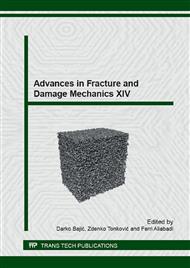p.61
p.65
p.69
p.73
p.77
p.81
p.85
p.89
p.93
Numerical Fracture Analysis of Compact Tension Shear (CTS) Specimens with Tortuous Crack Fronts
Abstract:
The aim of the contribution is to assess the influence of the microstructure of materials on the effective values of stress intensity factors. In this paper some results of 3D-finite element analyses of a CTS-specimen with a tortuous crack are presented. The specimen is subject to an in-plane shear remote loading (mode II) and tortuous crack flanks simulate rough cracks in polycrystalline materials. Finite element calculation by using the commercially available FE-code ANSYS has been carried out to determine stress/strain distribution in the vicinity of crack front and the local values of stress intensity factors are evaluated along the crack front. The existence of friction forces generated by sliding of crack wake asperities is included into calculations. Respective effective values are determined in dependence of the roughness of crack flanks. Results achieved allows to characterize the influence of microstructure to crack growth.
Info:
Periodical:
Pages:
77-80
Citation:
Online since:
September 2015
Authors:
Keywords:
Price:
Сopyright:
© 2016 Trans Tech Publications Ltd. All Rights Reserved
Share:
Citation:


